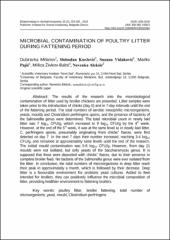Microbial contamination of poultry litter during fattening period

View/
Date
2019Author
Milanov, Dubravka
Knežević, Slobodan
Vidaković, Suzana
Pajić, Marko
Živkov-Baloš, Milica
Aleksić, Nevenka
Metadata
Show full item recordAbstract
The results of the research into the microbiological contamination of litter used by broiler chickens are presented. Litter samples were taken prior to the introduction of chicks (day 0) and in 7-day intervals until the end of the fattening period. The total numbers of aerobic mesophilic microorganisms, yeasts, moulds and Clostridium perfringens spores, and the presence of bacteria of the Salmonella genus were determined. The total microbial count in newly laid litter was 7 log10 CFU/g, which increased to 9 log10 CFU/g by the 4th week. However, at the end of the 5th week, it was at the same level as in newly laid litter. C. perfringens spores, presumably originating from chicks’ faeces, were first detected on day 7. In the next 7 days their number increased, reaching 3-4 log10 CFU/g, and remained at approximately same levels until the end of the research. The initial mould contamination was 5-6 log10 CFU/g. However, from day 21 moulds were not isolated, but only yeasts of the Saccharomyces genus. It is supposed that these were deposited with chicks’ faeces, due to their presence in complete broiler feed. No bacteria of the Salmonella genus were ever isolated from the litter. In conclusion, the total numbers of microorganisms in deep litter reach their peak in approximately a month, which is followed by their decrease. Deep litter is a favourable environment for probiotic yeast cultures. Added to feed intended for broilers, they can positively influence the microbial composition of litter, providing healthier environment to fattening broilers.
